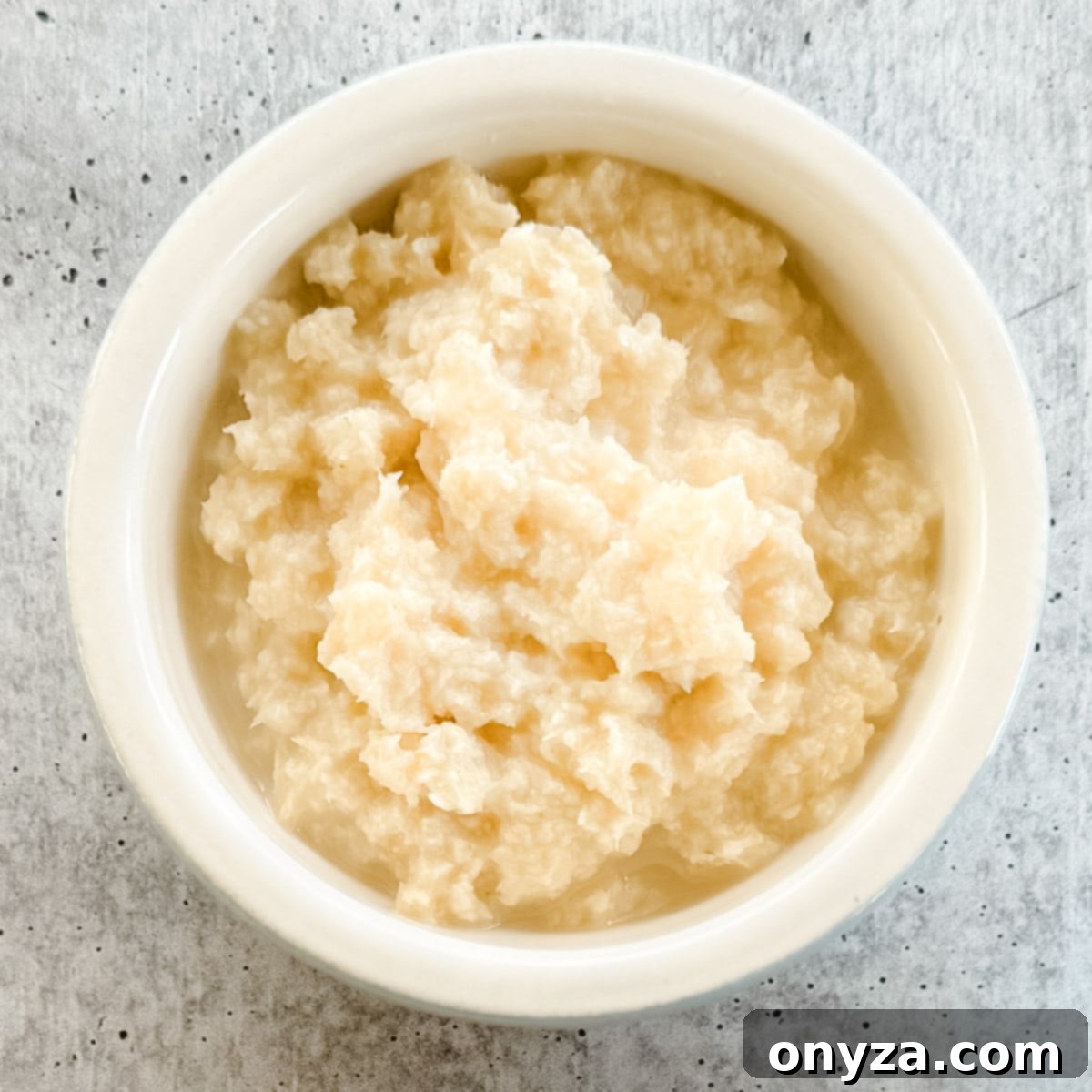Welcome to the definitive guide on horseradish, a dynamic ingredient that promises to awaken your palate. This comprehensive resource covers everything you need to know about the different types of horseradish available, how to expertly shop for the best quality, and creative ways to incorporate its distinctive flavor into your culinary repertoire. Whether you’re a seasoned chef or a home cook looking to explore new tastes, delve into the world of horseradish and elevate your dishes with its unique spicy zest.
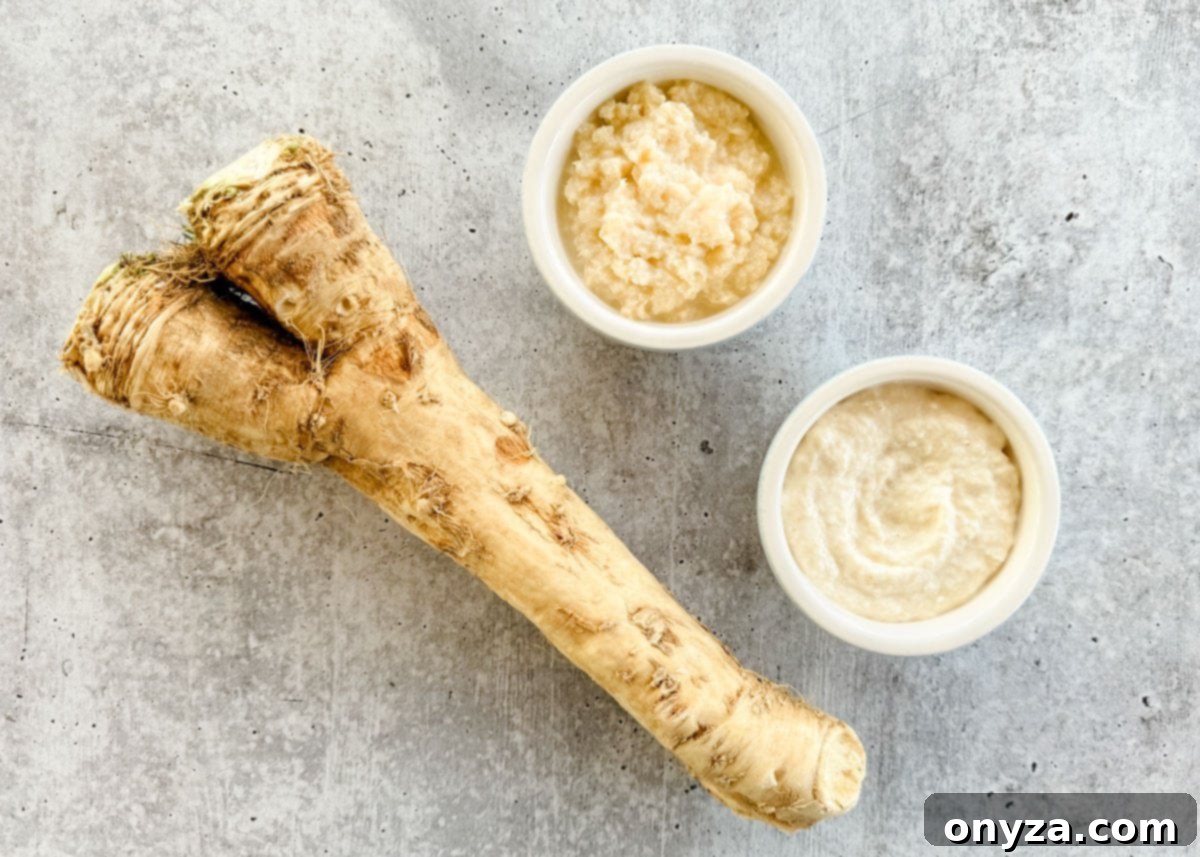
The Ultimate Guide to Horseradish: Fresh, Prepared, and Creamy Varieties
Discovering the Horseradish Plant: Origins and Characteristics
Horseradish, scientifically known as Armoracia rusticana, is a fascinating perennial herb and a proud member of the Brassicaceae family. This botanical lineage connects it to other well-loved pungent plants such as mustard, wasabi, broccoli, cabbage, and various radishes. Native to southeastern Europe and western Asia, horseradish has been cultivated for centuries, both for its culinary uses and its traditional medicinal properties.
Typically, the robust horseradish plant grows to an impressive height of 2 to 4 feet, characterized by large, vibrant green leaves. The root, which is the part most commonly consumed, is traditionally harvested either in the cool embrace of autumn or the invigorating burst of spring. This timing is crucial as it allows the root to develop its full, intense flavor profile.
Aspiring gardeners, take note! Horseradish is remarkably resilient and can be successfully grown as a perennial in USDA Zones 3-9. Propagation is typically achieved through root cuttings, making it a rewarding plant for the home garden. For detailed cultivation tips and comprehensive guidance, Penn State Extension offers an excellent resource titled Growing Horseradish.
While the vibrant green leaves of the horseradish plant are indeed edible and can add a peppery note to salads or cooked greens, it is the formidable root that commands most of our culinary attention. The horseradish root presents a rather unassuming exterior: long and cylindrical, with a rough, earthy beige-brown skin. It typically tapers gently at its ends, concealing a stark white, firm, and crisp interior that holds the plant’s distinctive potency.
The Pungent Power of Horseradish: Flavor Profile and Heat Mechanism
Horseradish boasts a uniquely robust, sharp, spicy, and distinctly earthy flavor. When consumed, its characteristic heat is not merely a taste sensation but a physiological experience, rapidly rising to the nose and often providing an invigorating clearing of the sinuses. This sensation is remarkably similar to that elicited by authentic wasabi or a potent, strong mustard, a testament to their shared chemical heritage.
The intriguing pungency of horseradish is, in fact, an evolved defense mechanism. It’s the plant’s clever way of deterring hungry animals and pesky insects from devouring its precious root. When the horseradish root is subjected to any form of damage – whether it’s chewed, cut, grated, or ground – a remarkable enzymatic reaction is triggered. This reaction produces a powerful compound known as allyl isothiocyanate. It is this volatile compound that is directly responsible for horseradish’s fiery, unmistakable flavor. What nature intended as a deterrent, however, has been embraced by chefs and food enthusiasts worldwide as a highly valued culinary asset, transforming ordinary dishes into extraordinary experiences.
Exploring Horseradish Varieties: From Fresh Root to Creamy Sauce
When you venture into your local grocery store or farmer’s market, you’ll encounter horseradish in several distinct forms, each offering a unique intensity and culinary application. Understanding these differences is key to choosing the right product for your recipe. The primary varieties include fresh horseradish root, prepared horseradish, and the milder, more versatile cream-style horseradish or horseradish sauce. Let’s delve into the specifics of each.
Fresh Horseradish Root: Unadulterated Potency
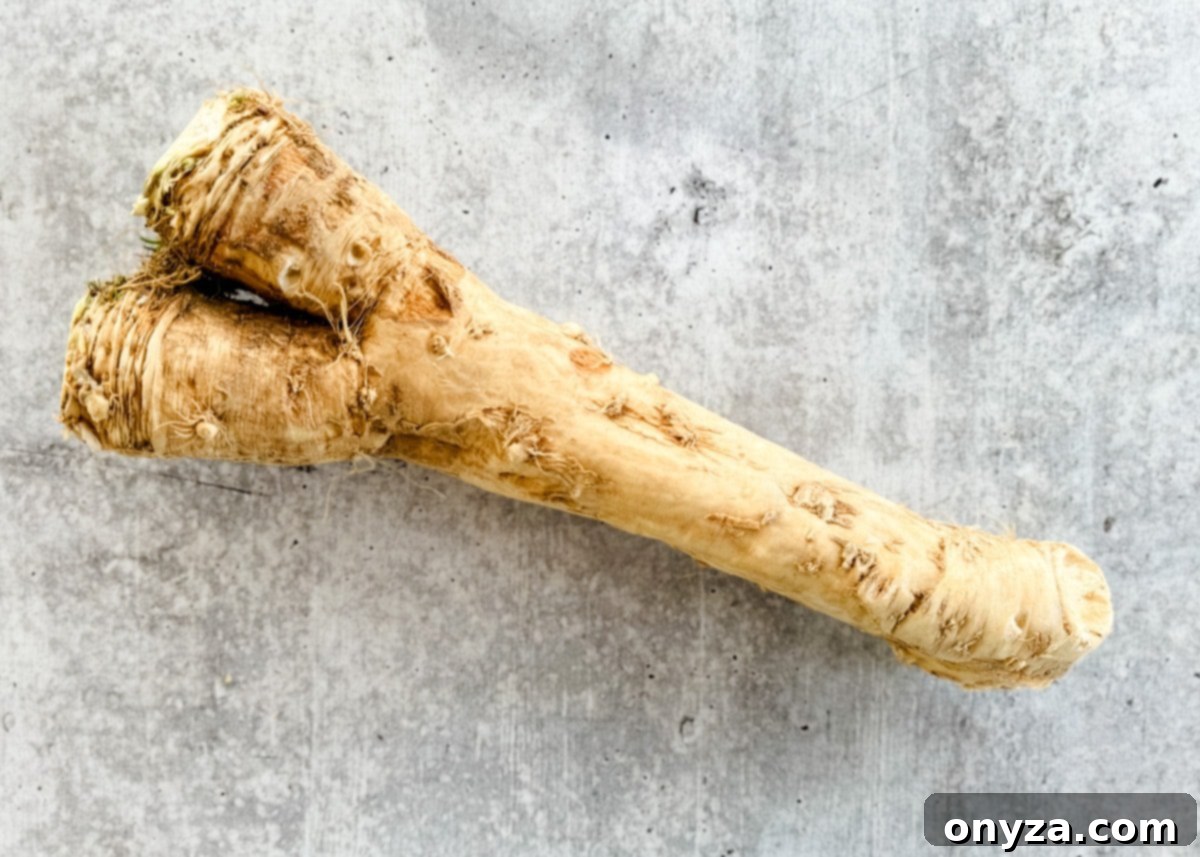
What It Is: Fresh horseradish root represents the purest and most potent form of horseradish available. Its flavor is unparalleled in intensity, offering a sharp, vibrant heat that can be exhilarating to the palate. Working with fresh root allows for complete control over the texture and strength of the horseradish in your dishes, providing the most authentic experience.
Where To Find It: Sourcing quality fresh horseradish root is often easier than you might think. Many well-stocked grocery stores carry it in their produce department, particularly during peak harvest seasons (fall and spring). Farmer’s markets are also excellent places to find fresh, often locally grown, horseradish. When selecting roots, always look for ones that are firm to the touch, feeling dense and heavy for their size. Avoid any roots that show signs of mold, soft spots, or excessive dryness. A tell-tale sign of an older root is sprouting; while edible, these roots tend to have a diminished flavor and can be tougher to work with.
How To Use It: Preparing fresh horseradish begins with removing its rough, earthy skin. A standard vegetable peeler works effectively for this, or you can carefully use a sharp knife. Once peeled, the gleaming white interior is ready for processing. The method you choose – grating, shredding, chopping, or finely grinding in a food processor – will depend on your desired texture and the specific dish you are preparing. For the most intense flavor and fine texture, a microplane grater is ideal.
An Important Safety Note for Fresh Horseradish: The volatile compounds in fresh horseradish root, particularly *allyl isothiocyanate*, can be quite irritating to the eyes and nasal passages. This sensation is akin to working with potent dried chilis. To ensure a comfortable experience when grating or chopping horseradish indoors, it is crucial to work in a well-ventilated area. Opening windows and engaging your kitchen’s vent fan can significantly mitigate the strong aromas. For added protection, consider wearing protective eyewear or even a damp cloth mask to shield your eyes and nose. For the ultimate comfort, if you have access to an outdoor cooking space, prepping your horseradish there is an excellent alternative.
Once the horseradish root is peeled and grated, it begins a process of oxidation. This exposure to air causes it to gradually lose its intense pungency and can lead to a bitter aftertaste. Furthermore, its beautiful creamy white color will start to darken, transitioning to shades of gray or brown. To preserve both its vibrant flavor and appealing color, it’s best to grate or chop fresh horseradish immediately before use. Alternatively, mixing it with vinegar as soon as it’s processed helps to stabilize the flavor-producing compounds and retain its lighter hue, a technique central to creating Prepared Horseradish.
Freshly grated horseradish adds an unparalleled spicy, aromatic kick to a vast array of dishes. It’s a superb addition to creamy mashed potatoes, invigorating beet salads, or sharp vinaigrettes. Classically, it’s a revered accompaniment to robust cuts of steak and delicate seafood, often folded into a rich, creamy sauce to balance its heat. Beyond these, consider using it in homemade cocktail sauces, as a vibrant addition to marinades, or even mixed into freshly ground burger patties for an unexpected pop of flavor.
Prepared Horseradish: Convenience Meets Zest
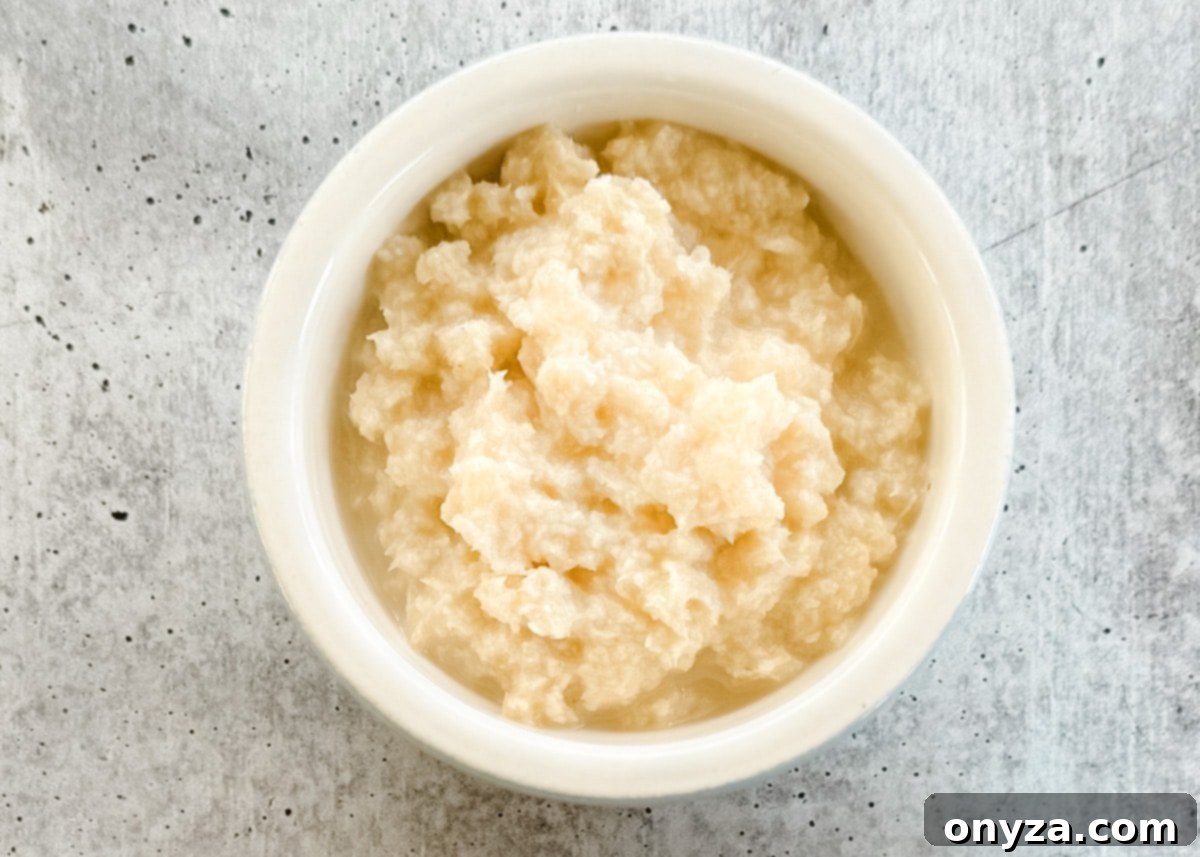
What It Is: In the United States, “prepared horseradish” refers to grated horseradish root that has been preserved in a brine primarily composed of vinegar and salt. This form is frequently labeled as “pure” horseradish, indicating its primary ingredient is the root itself. While undeniably spicy, prepared horseradish is generally less intensely pungent than its fresh counterpart. The key reason for this lies in the vinegar, which plays a crucial role in stabilizing the root’s heat-producing compounds, effectively mellowing its fiery edge while simultaneously imparting a pleasant tangy flavor that balances the spice.
Where To Find It: For the most superior flavor and quality, always opt for refrigerated prepared horseradish. You’ll typically discover it in various sections of your grocery store, including the dairy aisle, the fresh produce area, the seafood department (often near cocktail sauces), or even the deli section. Unlike many shelf-stable varieties, which might include fillers, artificial colors, or unnecessary additives, refrigerated versions maintain a purer, more authentic taste and a better texture. When shopping, make it a habit to scrutinize the ingredient label. An ideal prepared horseradish should have a straightforward list: primarily horseradish root, vinegar, and salt, with some brands occasionally including “natural flavor.” Reputable and popular brands known for their quality include Gold’s, Boar’s Head, Ba-Tampte, and a personal top recommendation, Kelchner’s.
How To Use It: Prepared horseradish offers a fantastic level of convenience, allowing you to infuse dishes with the robust heat and distinctive flavor of horseradish root without the effort of peeling and grating it yourself. Its versatility makes it a staple in many kitchens. Here are some inspired ways to incorporate it:
- Stir it into creamy sauces and vibrant salad dressings to impart a zesty, piquant kick. It’s a cornerstone ingredient in classics like Homemade Russian Dressing, essential for authentic Cocktail Sauce, and transformative when mixed into mayonnaise for a horseradish mayo (as featured in my Ultimate Steak Sandwich).
- Fold it into fluffy mashed potatoes or enrich savory vegetable purees, such as those made from carrots or parsnips, for an unexpected layer of flavor and warmth.
- Elevate your brunch cocktails by blending a spoonful into classic Bloody Marys, adding a profound depth and spicy finish.
- Mix it directly into ground burger meat, meatloaf, or meatballs before cooking for an internal burst of heat and complex flavor.
- Use it as the foundation for creating simple yet elegant creamy sauces, perfect for accompanying roasted meats, or as a vibrant dip for crunchy chips and fresh vegetables. (See the Cream-Style Horseradish section below for more details.)
- Add a teaspoon or two to hearty soups or rich beef stews during the final stages of cooking to introduce a spicy depth that complements savory broths and braised meats.
Make It At Home: For those who appreciate the freshest possible flavors, making your own prepared horseradish at home is a rewarding endeavor if you have fresh root readily available. This allows for complete customization of heat and tang. Simply Recipes offers a clear guide on how to prepare horseradish to store in your fridge, ensuring an exceptionally fresh and vibrant condiment.
Cream-Style Horseradish and Horseradish Sauce: Smooth and Mellow Heat
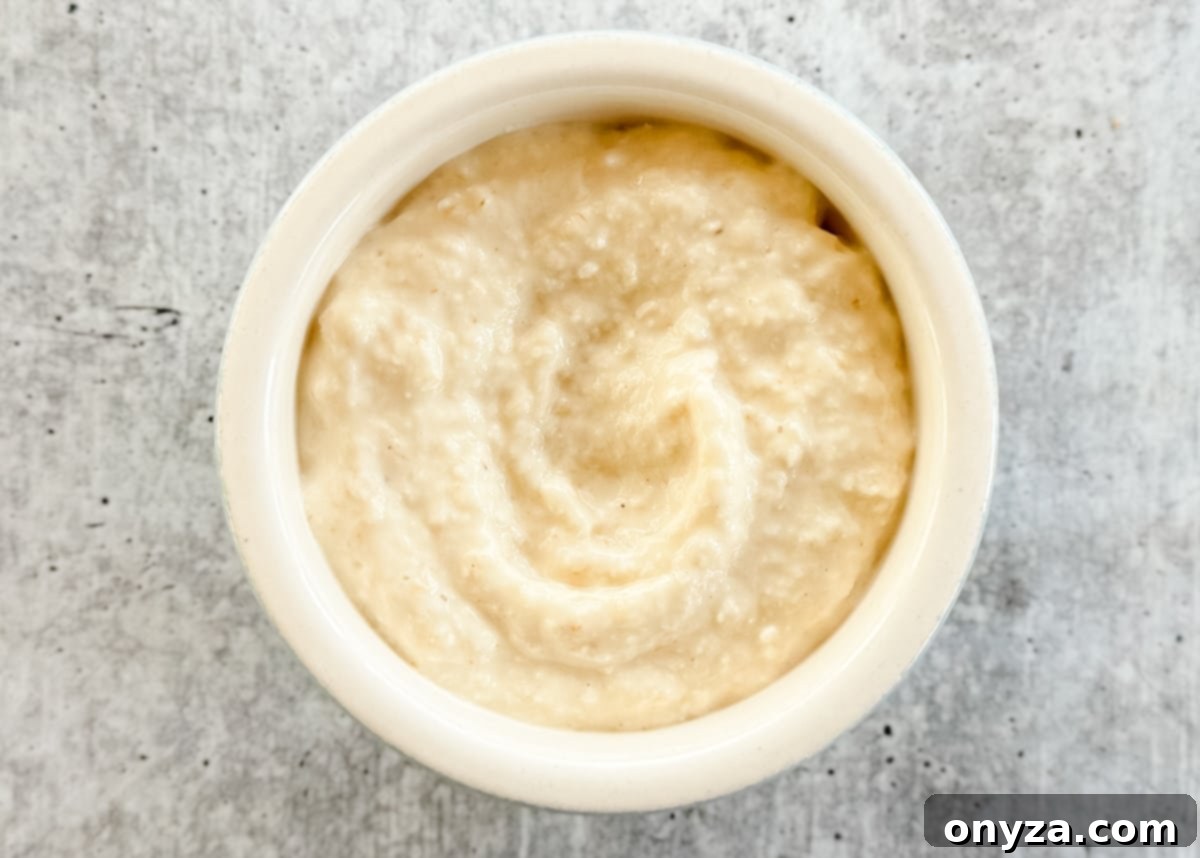
What It Is: Cream-style horseradish, often simply referred to as “horseradish sauce,” represents a delightful fusion where grated or prepared horseradish is expertly blended with a creamy base. Common bases include sour cream, crème fraîche, mayonnaise, or rich heavy cream. The result is a condiment with a significantly smoother texture and a noticeably milder, more approachable pungency compared to its fresh or merely prepared counterparts. This creaminess rounds out the sharp heat, making it incredibly versatile and appealing to a broader range of palates.
Where To Find It: These convenient sauces are typically located in the condiment aisle of most grocery stores, alongside other bottled dressings and sauces. You might also find chilled varieties, often boasting a fresher taste, in the same refrigerated sections where prepared horseradish is sold, such as the dairy or deli areas. The heat level of commercially available horseradish sauces can vary considerably between brands, so a little experimentation might be necessary to find your preferred intensity. Among the shelf-stable options, Inglehoffer is a highly regarded brand that consistently delivers a satisfying and well-balanced heat within its creamy formulation.
How To Use It: Keeping a good bottle of cream-style horseradish or a ready-made horseradish sauce in your refrigerator is a brilliant culinary hack. It offers an immediate burst of zing and flavor to numerous foods without any additional preparation, making it perfect for quick meals or enhancing last-minute dishes. Its smooth texture and balanced flavor make it incredibly versatile:
- Use it as a dynamic spread for sandwiches and wraps, instantly upgrading everyday lunches. It’s particularly fantastic in recipes such as my French Dip Sliders, or as a flavorful component in elegant puff pastry appetizers like my Savory Palmiers with Bacon and Gruyere.
- Incorporate it into deviled egg fillings for an unexpected, spicy twist that elevates this classic appetizer, as demonstrated in my popular Bacon and Horseradish Deviled Eggs recipe.
- It serves as an effortlessly sophisticated condiment for a variety of roasted meats. It’s an indispensable pairing for succulent steak, luxurious prime rib, or traditional corned beef, adding a gourmet touch with minimal effort.
- Beyond these, consider swirling it into potato salads, whisking it into a quick dip for crudités, or even using it as a vibrant spread on charcuterie boards.
Make It At Home: Crafting your own creamy horseradish sauce using prepared horseradish is incredibly simple and highly recommended, especially when you’re preparing a special roast for a holiday gathering. This homemade approach allows you to precisely customize the sauce’s flavor and heat level to perfectly match your personal preferences or the dish it accompanies. For a timeless and perfectly balanced recipe, try my Creamy Horseradish Sauce. For an intriguing variation, my Roasted Garlic Horseradish Cream Sauce introduces the wonderfully sweet, nutty, and mellow notes of slow-roasted garlic into the creamy mix, creating a more complex and incredibly addictive condiment. This roasted garlic version is a particular favorite in my household, not just with roasts, but also as an irresistible dip for crispy potato chips or golden french fries!
Tips for Storing and Maximizing Your Horseradish Experience
To ensure you get the most out of your horseradish, proper storage is essential for maintaining its pungency and flavor. Fresh horseradish root, if unpeeled, can be stored in the refrigerator for several weeks. Wrap it loosely in a damp paper towel and place it in a plastic bag or airtight container to prevent it from drying out. For longer storage, you can peel, chop, and freeze fresh horseradish in airtight containers for several months, though some of its potency may diminish over time.
Prepared horseradish, once opened, should always be kept refrigerated in its original sealed jar. Its vinegar base helps preserve it, but its heat will gradually lessen over time. Aim to consume it within a few months of opening for the best flavor. Cream-style horseradish sauces also require refrigeration after opening and should be used within the timeframe recommended on the packaging, typically a few weeks to a couple of months, due to their dairy or mayonnaise content.
Experimenting with horseradish is part of the fun! Don’t be afraid to adjust quantities based on your heat preference. A little can go a long way, especially with fresh root. Whether you’re aiming for a subtle tang or a powerful sinus-clearing kick, horseradish offers an exciting dimension to countless dishes, transforming the ordinary into the extraordinary.
Conclusion: Embrace the Zest of Horseradish
From its humble beginnings as a robust root to its diverse forms as a culinary staple, horseradish offers an unparalleled journey for the taste buds. We’ve explored the pungent power of the fresh root, the convenient tang of prepared varieties, and the smooth, mellow appeal of cream-style sauces. Each type provides a unique way to infuse your meals with its distinctive, fiery character. By understanding how to select, prepare, and store this versatile ingredient, you are now equipped to unlock its full potential in your kitchen.
So, go forth and experiment! Let the invigorating zest of horseradish inspire your next culinary creation, whether it’s a hearty roast, a fresh salad, or a simple sandwich. Its ability to add depth, heat, and an undeniable ‘zing’ makes it a truly indispensable ingredient for any adventurous cook. Embrace the fire, and enjoy the transformative power of horseradish.
